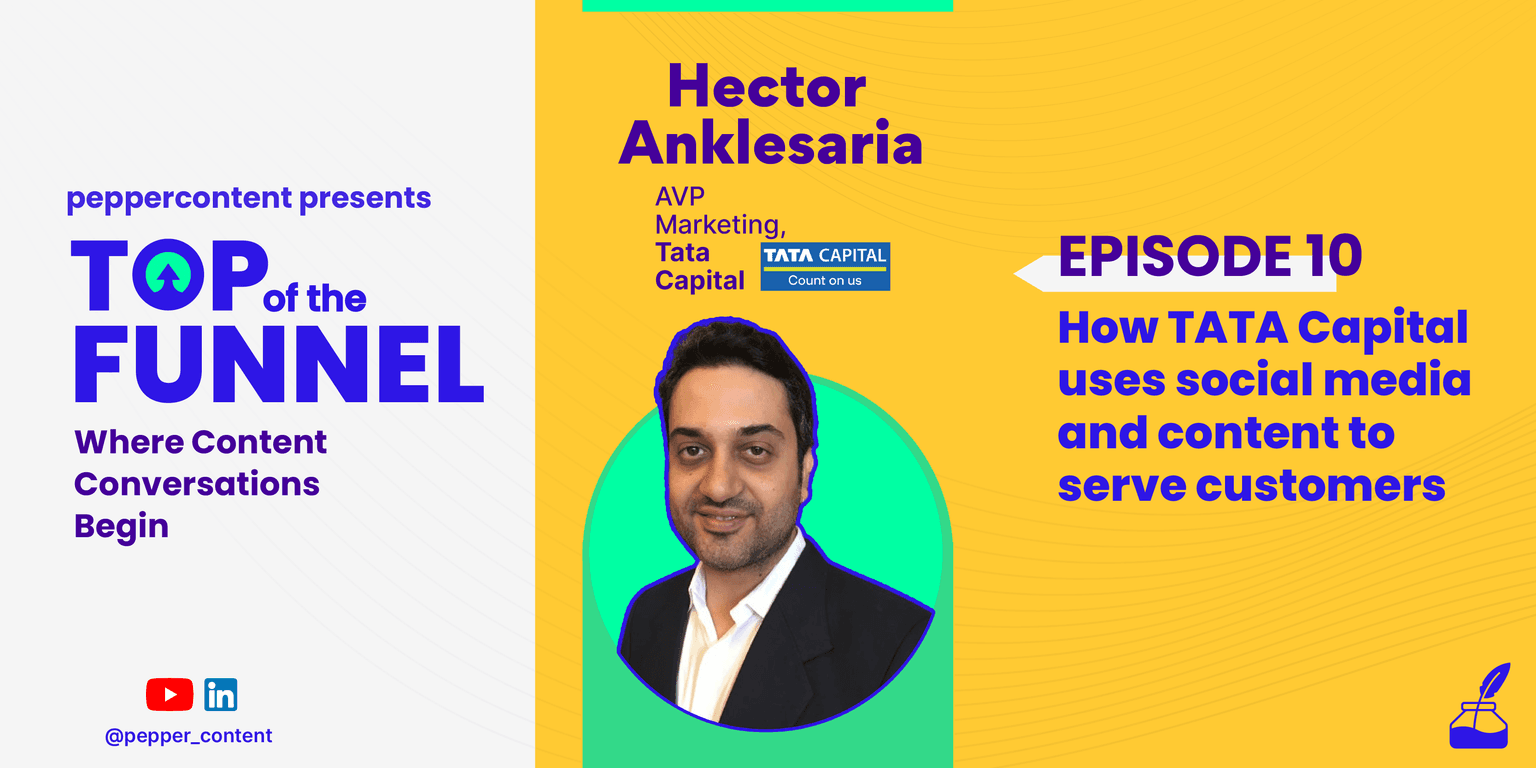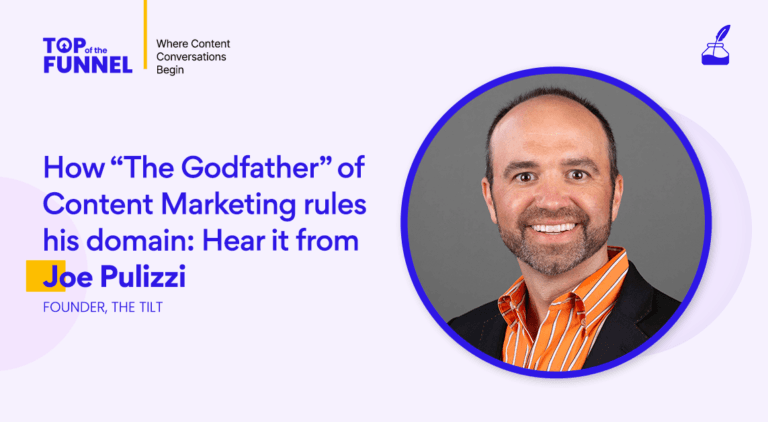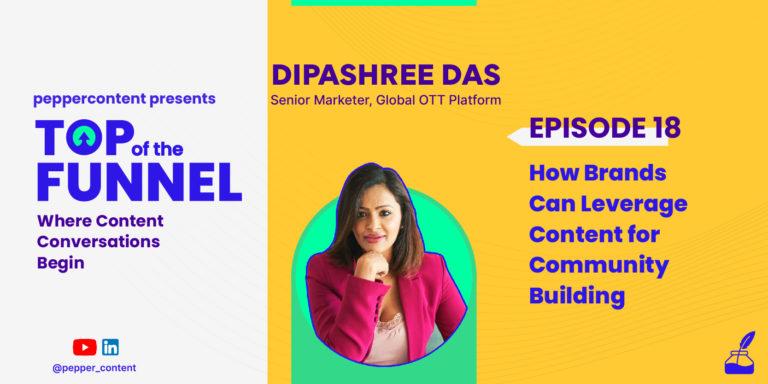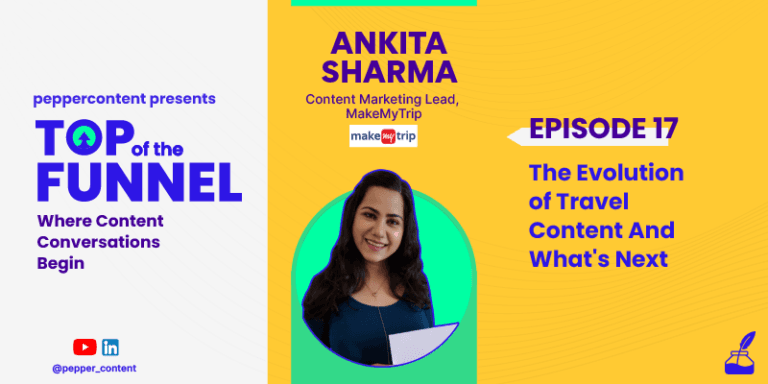Episode #10: How Tata Capital uses Social Media and Content to serve Customers

A few years back, digital content was only restricted to emails and text messages. Websites had only begun to look up. There was no concept of customized content for consumers. The internet, as we see it today, did not exist back then. As the digital space grew, brands could no longer ignore the power of search engine optimization (SEO). Nowadays, content is the backbone of every brand’s marketing strategy. It is the primary lead generation tool across industries and has been a significant contributing factor to drive growth.
Natasha Puri, Content Marketing Lead at Pepper Content, talks to Hector Anklesaria, Associate Vice President of Marketing at Tata Capital about the evolution of content in the insurance space. With 15+ years of marketing experience under his belt, he reveals his journey as a marketer, how the digital space evolved, and how has the content business changed in the last few years.
Natasha Puri: Hello everyone. Welcome to Top of the Funnel, the series where conversations about content begin. Our guest today is Hector Anklesaria, Associate Vice President of Marketing at Tata Capital. This chat promises to be very informative and insightful. Hector Anklesaria has almost 15 years of marketing experience under his belt. He has seen the digital space evolve to what it is today.
I would love it if you could outline your journey as a marketer until now. How has the digital space evolved? What is your present role as AVP at Tata Capital?
Hector Anklesaria: I have not changed industries much. I have been in the financial services and investments sector for some time now, mostly in insurance and now in inland investments. Gmail was only about a year old when I started working. So, you can imagine how old I am actually. It gives you a glimpse of what I have seen over the years. My first stint was in sales. I used to sell concepts, event sales, as they call it. While it was a short stint, I got a lot of perspectives from it. My pitches were for brand managers and media managers. Content managers did not exist then. It was very closely connected to the content. It was about content but restricted to the physical world. In the digital space, there were emails.
The first few years that I have spent in marketing were really interesting. The fundamentals of marketing were changing There was an undergoing digitalization at a large scale. You cannot change everything in a day, but there was still a big leap then. India was undergoing digitalization at a mass scale. Websites were coming up with a stronger presence to engage with the audience, to establish themselves as the first point of contact with the audience.
There were issues with Internet speed. Tech would drop many times a day, not the kind of lag we experience now. Basic issues would also keep cropping up. It was a very different world. The challenges were also very different. We started with something wherein we struggled with making jpeg mailers. HTML coding was explored iteratively. The cost of video content was also very expensive. The inordinate delays, with that kind of simple content, were a different scenario altogether. We have come a long way since then.
At that time, people were also skeptical of change. We, ourselves are guilty of doing that at some point. After some time, people themselves turned the game around. From being something that people found difficult to accept, now your position and acceptance as a marketer depends on how deep you are in the digital marketing world. Having said that, it is also a medium like TV, radio, and print were. One should not make too much noise about it. The shift that digital mediums have brought far outweighs the limitations. One cannot even begin to compare the two. This is how digital has progressed.
I have been in the same industry. So, what happens is you become a much faster processor. You understand the role of marketing in those functions well. You understand the industry inside out in all possible ways. In my life, I started with a really big life insurance company, to shift to a smaller, digital-first life insurance company. Then, I moved to a digital, health insurance company. Now, I am working at Tata Capital. These were companies, who appreciated the role of digital. Were they first in doing everything digital? Probably not. I have been fortunate in the sense to work with BTL, then brand, and so on. Everything is seamless and integrated, even for agencies. There are very few companies nowadays, who work in sideways and verticals. From my perspective, this is how the journey of digital has been, for the past many years.

Natasha Puri: You spoke about how the cost and infrastructure of content have changed. Can you go into slightly more detail on how you think the content has evolved? Maybe, you could dive into a few examples. Since you are an expert in the industry, can you comment on how a piece of content has evolved over the years?
Hector Anklesaria: It is very difficult to describe in words, for the leap that I talked about earlier from where we were struggling to do basic tasks to now, is great. It is not just tech changes. That perception has also evolved a lot over the decades. Content is malleable. When I say that content is malleable, I do not mean that other things in the marketing world are not malleable.
It is a very personal opinion but, content is available everywhere and it has to be either educative, informative, or entertaining. When I say entertaining, I mean emotional, or funny. The resources were very limited then. Who were the producers of content? The content was mostly led by mainstream media. You could gather information from friends, colleagues, and training programs. The content was very one-on-one. Media was for everyone, but I am not sure if Hector was receiving content for Hector. It was a constraint.
I remember in my pre-working days, in college, we went to libraries to do a project for the entertainment industry. We went through magazines and journals to dig out data. In that sense, the Internet existed, but everything did not exist on the Internet. It was a seller’s market. The content was a very small part of the marketing structure. Only a few producers existed. It was directed from one to many, but not many consumers existed back then. When websites became the first point of contact, not only did it change companies who were selling products and services but also media houses who were running this content for generations joined the digital space. Over some time, customers had also increased. If the Times of India gives me five more articles to read, I would read them if I were a voracious reader. Producers and customers, both increased manifold over a few years.
Another factor that ought to be noted is that we were no longer gathering data, information, education, and entertainment from the physical world. Income levels were rising. We moved from wired to handheld devices. Technology is still upgrading and bringing better devices to play. Earlier, I was content with picking up a newspaper and reading everything. Newspapers still have their value. But, now I know that I can get something customized to my tastes. The content went from being an irregular component to a crucial part of a marketing plan.
SEO catapulted content marketing into being what it is today. Companies were forced to look at websites and SEO. They were also looking at other content. There were always some smart players in the market going the extra mile. This drastically changed how brand managers, marketers, agencies, even media houses viewed content. This is how the journey of content has largely been, in my opinion.
Natasha Puri: Inbound has taken over. Your customer has evolved and you are also trying to attack your customer with content. They are seeking more information and you are also required to deliver. If you can be a little more specific, what are the primary pillars of marketing at Tata Capital? How is your team structured? What place does content have in your marketing strategy?
Hector Anklesaria: Tata Capital has evolved a lot, as an organization, and now, we place a greater emphasis on data-driven decisions and digital journeys, where customers can come and experience our products online. Customer satisfaction is another area, where marketing strives to contribute. The third area, which we call customer obsession at Tata Capital, is also an important focus area for us. The role of brand, PR, marketing, and digital marketing has a very crucial role to play in this conversation. We are at the front end of the company. The company is known for what we do. Anything that the consumer sees, reads, consumes, would make up his perception of Tata Capital.
The content creation is distributed across teams. The digital marketing team looks at SEO and content on blogs and websites. My team manages social media. We churn out a lot of content for Youtube, Facebook channel, and Instagram. We try to make content with our customers in mind. Content has to be relevant. If it is relevant, it would be engaging. This is Tata Capital’s focus area when creating content.
Natasha Puri: Social is so exhaustive. Within social, we have so many platforms to cater to. Are there some lessons that have helped you to create content for social media? In a post, is it channel first, and then content? Do you think people should create content for Youtube specifically, and then move on to other platforms? What is your philosophy You have spent a lot of time growing your social presence? It has also grown, to some extent with you. Would you like to say about that?
Hector Anklesaria: One should look at platforms from a figuring mechanism. I am not of the opinion, that one should indiscriminately create content separately for all the different platforms that the company engages in. The platform does play an important role, for what I am doing on Twitter is different than my approach on Linkedin. What I am doing on Facebook is different from what I am doing on Instagram, to a certain extent. We primarily engage on these four platforms. We should customize the content according to each platform. It should be specific.
The producer of content is not necessarily a big deal. I am just borrowing from the previous question, but the content has ceased to be the sole copyright of intellectuals, domain experts, and creative people. Of course, it has its disadvantages too. It has become accessible not only from the audience’s point of view but also from the point of view of someone, who thinks he or she can create content.
It has also enabled the confluence of PR, social, website, and any other sort of marketing. These things hang on each other. What we are doing right now is an example of that. It is relevant to both parties, myself as a marketer to be a part of this conversation and relevant for you as a content creator to be a part of this conversation. Hopefully, the audience would also engage with it. We will eventually put this video on our social networks. We should play a lot of emphasis on relevance. It should be the cornerstone of any content marketing strategy. The customization of content is very important.
My first filter for any content marketing depends on the kind of industry it is for. Are you operating in an industry that requires you to generate a quantum of content vis a vis quality of content? For example, it would not make sense if you meaninglessly apply the strategies tailored to tech companies anywhere else.
Natasha Puri: In that sense, what do you think is the philosophy for your industry?
Hector Anklesaria: I think it is a balance. The financial industry has come a long way, from being a slow-paced, bureaucratic industry. I am not generalizing my statement to all fintech. But, it used to be like this, to a large extent. We have moved on from where we were. Therefore, I think that a balance needs to be there. Our SEO strategy, for example, is a number game. Of course, quality is a filter. But, you cannot say that you will only generate one or two pieces. One has to look at hundreds of pieces because you are driving a certain conversation.
One needs to balance it out. If you run behind quantity, it will be a vicious cycle. You would be generating more and more content. The system will accept that content. But, are you able to generate meaningful content day in and day out? Therefore, there should be a balance between what you would like to achieve in the long-term and your short-term goals.
Natasha Puri: This is where your brand story, brand values, and brand communication come in. It becomes an integral part of what kind of content you would want to create. It also determines your content philosophy. Doesn’t it?
Hector Anklesaria: Of course. It matters to a great extent. There will be different people working on SEO content, or website content. I do not think that we can thrive in isolation anymore. We use blogs for our social network. We give them space on our promotions to ensure that they have enough things that they want to talk about on social media. The confluence between these functions is very important. It is not the world of physical PR anymore, though television still exerts some influence. We cannot operate in silos anymore. I have to give equal focus to creating content for my Linkedin page, which is completely unrelated to media, and I also have to ensure that the content from the PR team is amplified enough for it to gain momentum on social media. It works both ways.
The three filters, as I was talking about earlier is industry, basics, and relevance. You cannot meaninglessly create content for one industry and apply that to another.
You have to understand the basics. My Youtube channel may have really bad content, but I would still be running after creating more content. It will give short-term benefits, but will not work in the long run. It is a piece of content. You will promote it to get some traction on it. It won’t yield long-term benefits, or unlock the actual potential that content marketing has to influence a customer over a period of time. The brand cannot thrive in isolation. You cannot look cool in your brand, and not so cool in your content. It also cannot be the other way around that the brand is looking old and outdated, but your content is doing all the talks.
I cannot emphasize enough that relevance is absolutely essential for content marketing to work. If it is relevant, I will read that commodity. If it is not, I won’t engage with it. I will not engage with it, no matter how well you market it. It has its limitations. The core of the content is the satisfaction that the customer will get from seeing it and engaging with it.

Natasha Puri: On that note, would you like to talk about some campaigns that you deem successful? How would you define that success?
Hector Anklesaria: There are some basic metrics that everyone follows, like brand scores, consultations, leads, and so on. If I had to talk about engagement specifically as content, I suppose that one needs to step back and make engagement the first metrics to look at. Last year, we did an influencer campaign. It was a social media campaign. To begin with, the engagement was not as we had desired. People were engaging, sharing, and so on. But, if I had to be completely ruthless in my analysis, I should only check my engagement rate. I should only check my interactions on the campaign. Other things are also not future. Rather, they are quite important. They are just not my first filters to check if a campaign was successful or not.
To give you an example of a recent campaign, we did something called ‘Shubharambh loans.’ It was a brand campaign. Like we were discussing before, a brand campaign is not just simply a brand campaign anymore. We did some ads on television, social media marketing, influencer marketing, PR, and so on.
There was absolutely nothing that we did not do. Consumers are everywhere. As conventional as the theory is, the multiplier effects even today. If I see your advertisement on television, then I again see that on social media, I am more likely to be influenced. The traffic from the website, the traffic from leads, brand scores, engagement rates, videos, everything was stalked to understand what was working.
I do not think that there is an option to not take content into account anymore We cannot just give up and say that it is not working anymore. Content is integral to the marketing conversation now. But, it gives you an idea of what went wrong, or what went right.
Natasha Puri: Did the pandemic affect your customer communication on socials? Did the informative and educative content approach have an impact?
Hector Anklesaria: It depends from industry to industry. But, most companies would say that informative content has given them good results. Social is an important pillar to distribute content on a regular basis and to regulate content marketing efforts. We became cautious and sensitive about what to say on social media. It was the first step that we did after the pandemic. Then, we became more informative on what was going on.
It was not just about the pandemic, but information on how they can reach us, how they can access our products, and so on. Is there an end-to-end journey possible? It was not possible to step out. Initially, we were curtaining the number of people, who were forced to step out. They would be putting themselves at some form of risk, including our employees. Some might say that we were overcommunicating, but I do not think that it was wrong. The pandemic changed how we viewed communication. Did it change 180 degrees? I do not think so, for we were already on the path of doing those things.
The pandemic has catapulted the conversation on digital media in our world by a couple of years. Sensitivity, ability to provide consumers with what they would need without stepping out of their houses, getting servicing done from their devices, and so on. We tried to provide tutorials. If one needed to navigate a portal that was new to them, we tried to help them.
Natasha Puri: Would you like to shed some light on the formats that you have used? Video is the highlight of the day. Audio content has also emerged to be important. There is the usual text format. Are there any formats that you feel excited to experiment with, in your industry?
Hector Anklesaria: In the last two years, we have done a lot of influencer marketing. Before that also, I guess Tata Capital had been dabbling in influencer marketing for some time and driving content through them. It is quite challenging to choose an influencer like you would choose a brand ambassador. I think the filter helps. The more emphasis you lay on the kind of influencer that you are engaging with is reflected in results. It adds another layer to the media plan. It is a human interacting with the audience, someone they admire and look up to. Therefore, the reception of that conversation becomes fairly easy. I don’t just go up to the most popular one and ask them to drive conversations.
I cannot reiterate the importance of videos. I think we have gone to another level of marketing video content. I think videos do a lot better because of the audio-visual element. You are seeing something interesting in an interesting format, so it drives engagement. It speaks in both audio and visual mediums. Some customers may just look at the video. The number of companies churning out high-quality video content is still fairly low. Mobile networks and devices are better. It will become increasingly popular and relevant in the upcoming years. People are engaging with that kind of content now.
The number of people with a good internet connection and a good device was low in the previous years. Now, it is not the case. The pandemic has added to this conversation. I would not yet dismiss the text content. It is still an important part of any content marketing strategy, simply because of its quick production. It is non-inclusive, so it holds a lot of equity with the audience.

Natasha Puri: We have spoken about the past and present of content marketing. My final question to you is, what do you think of the future of content marketing?
Hector Anklesaria: I think it is going to grow on a large scale. Its graph is going to be phenomenal. We have to bear in mind something. Often, marketers tend to become impatient with content. They expect that the performance of content marketing would be equal to that of early-generation campaigns. I think it is unfair, for content marketing does both things.
Blogs and videos add meaningful conversions about your website and business in the short run. In the long run, it earns you loyalty. It is an asset. If you are adding value for a customer, they will come back to you.
You cannot be impatient with content marketing. The future is a rise in video content and influencer marketing, and other forms of content that we probably do not know now. Unless the world does a reset by sending us back to the analog world, the digital world is only going to influence and prosper. Content, itself adds a brilliant layer to performance marketing and influencer marketing. Before content arrived, it was still there. And, it is only going to grow from here.
Natasha Puri: You perfectly summarized it. It is hard to imagine marketing without content nowadays. On that amazing note for people like me, thank you for having this conversation and adding your little gems of wisdom for our audience.
Hector Anklesaria: I hope this will give you good engagement. I had a lovely time. Thank you.
Latest Blogs
Explore how Google’s 2025 AI search updates triggered ranking chaos. Learn actionable strategies to adapt your SEO for AI Overviews, zero-click searches, and SERP volatility. Stay ahead now.
Learn how to rank on AI search engines like ChatGPT, Perplexity, and Gemini by optimizing your content for authority, structure, and relevance. Stay ahead in AI-driven search with this strategic guide.
Explore the best healthcare SEO services for your medical practice. Improve online visibility and effectively reach more patients in need of your services.
Get your hands on the latest news!
Similar Posts

Expert Speak
18 mins read
Season 2 Episode #1 How “The Godfather” of Content Marketing Rules His Domain: Hear It From Joe Pulizzi

Expert Speak
16 mins read
Episode #18: How Brands Can Leverage Content for Community Building

Expert Speak
11 mins read